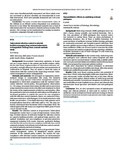Tuberculosis infection control in selected facilities managing drug-resistant tuberculosis in Bangladesh: Findings from a mixed-methods study
Citation
Parray, A. A. (2021). Tuberculosis infection control in selected facilities managing drug-resistant tuberculosis in Bangladesh: Findings from a mixed-methods study. International Journal of Infectious Diseases, 101(Supplement 1), 305. doi:https://doi.org/10.1016/j.ijid.2020.09.797Abstract
Background: Nosocominal Tuberculosis epidemics in hospitals are a major threat to the patient and health workers safety. On the other hand, implementation of Tuberculosis infection control policy, strongly influences the prevention and transmission of Tuberculosis in hospitals. Thus we aimed to check the status of Tuberculosis infection control in the major drug-resistant Tuberculosis management centers of Bangladesh.
Methods and materials: We leveraged an explanatory mixed-methods design to contextualize this study. We included (n = 3) major drug-resistant Tuberculosis management centers of Bangladesh to check their complaiance with the national Tuberculosis infection control policy. Non-participatory observations (n = 18) using a structured observation checklist and record review using standard document review checklist were employed to check the extent of the implementation of infection control policy. After the quantitative data were analyzed, indivually at each hospital, we developed guidelines to explain the reasons for non-compliance with the Infection control standards. Hence, we conducted 9 Key-informant interviews with Managers,16 In-depth Interviews with health care providers, 12 In-depth Interviews with patients and 6 In-depth-phone Interviews with field staff (n = 43). The data collection commenced from November 2018 to December 2018. The ethical approval for this study was sought from BRAC James P Grant school of public health.
Results: The infection control at drug-resistant Tuberculosis management centers have a scope of improvement. Survey findings revealed absence of dedicated budget for infection control, no capacity building activities, sub-optimal triage practices, sub-optimal ventilation, and non-compliance to personal protective equipment including N-95 masks. However, qualitative findings revealed that the reasons for non-compliance with infection control standards included; lack of funds, lack of infection control committee, lack of authority and lack of training.
Conclusion: Infection control practices at drug-resistant Tuberculosis management centers of Bangladesh require special attention of the national policy makers. The reasons for non-compliance with infection control standards are interconnected and represent asymmetries at individual, hospital and national levels.

